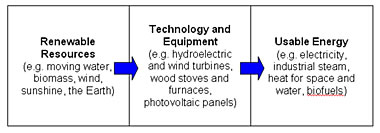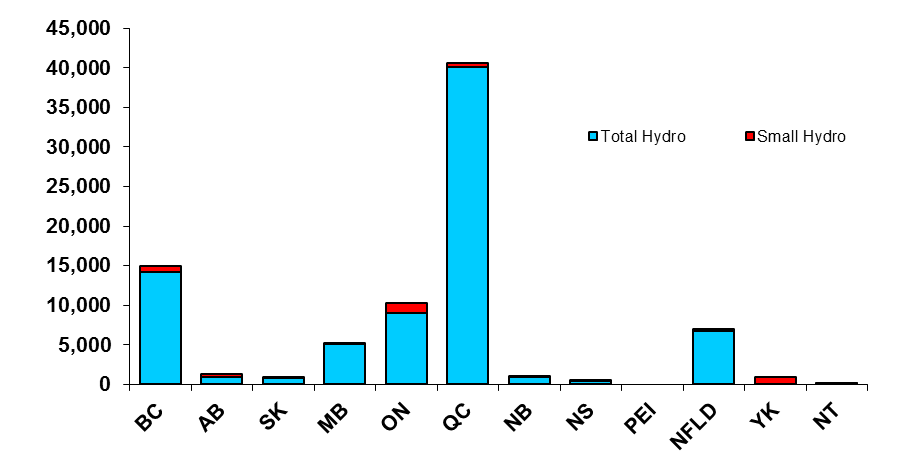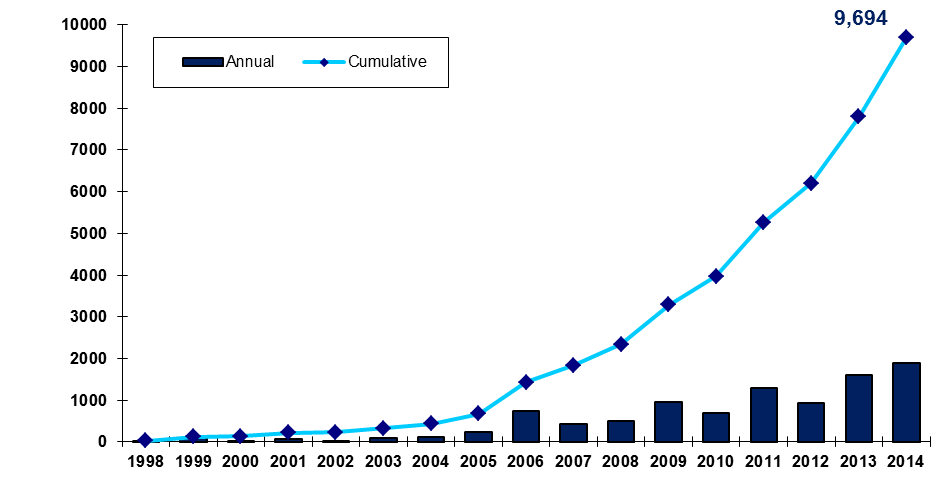Which Of The Following Is Least Likely To Waste Large Amounts Of Energy And Money When Used?
Content
- Canada, with its large landmass and diversified geography, has substantial renewable resource that can exist used to produce energy; these resource include moving water, wind, biomass, solar, geothermal, and ocean energy.
- Canada is a globe leader in the production and use of energy from renewable resources. Renewable energy sources currently provide near eighteen.9 per cent of Canada's total main free energy supply.
- Moving water is the most of import renewable free energy source in Canada, providing 59.three per cent of Canada's electricity generation. In fact, Canada is the second largest producer of hydroelectricity in the globe.
- Current of air is the second most important renewable free energy source in Canada. It accounts for 3.five per cent of electricity generation in Canada.
- Biomass is the third largest renewable source of Canada's electricity generation. Its share in Canada'south electricity generation is 1.4 per cent.
- Wind and solar photovoltaic energy are the fastest growing sources of electricity in Canada.
What is Renewable Energy?
Renewable energy is energy derived from natural processes that are replenished at a charge per unit that is equal to or faster than the rate at which they are consumed. There are various forms of renewable energy, deriving directly or indirectly from the sun, or from rut generated deep within the globe. They include free energy generated from solar, wind, geothermal, hydropower and body of water resources, solid biomass, biogas and liquid biofuels. Biomass, withal, is a renewable resource simply if its charge per unit of consumption does not exceed its rate of regeneration.
A broad range of energy-producing technologies and equipment have been developed over time to take advantage of these natural resources. As a result, usable energy can be produced in the form of electricity, industrial rut, thermal energy for space and water conditioning, and transportation fuels.
With its large landmass and diversified geography, Canada has an abundance of renewable resources that tin be used to produce free energy. Canada is a world leader in the production and apply of energy from renewable resources. Renewable free energy resource currently provide 18.9 per cent of Canada'southward total master free energy supply.
Hydroelectricity is by far the most important form of renewable energy produced in Canada. Air current and bioenergy as well brand an of import contribution to Canada's energy mix. Wind and solar photovoltaic power are experiencing the highest growth rates.
The Renewable Energy Universe

Larger image
Text Version
The tabular array describes the renewable energy transformational universe from the state of a natural resource to the state of useful forms of energy. It consists of 3 sections with the arrows going from the first department to the second and from the second to the tertiary. The first section shows the renewable resources, with the examples such equally moving water, biomass, air current, sunshine, the Earth. The second i presents technology and equipment showing the examples of hydroelectric and wind turbines, woods stoves and furnaces, photovoltaic panels. The tertiary section displays usable energy with the examples of electricity, industrial steam, heat for space and water, biofuels.
Hydroelectricity
The natural flow of water in rivers offers kinetic power that can be transformed into usable energy. Early usages included mechanical ability for transformation activities, such as milling and sawing, and for irrigation. Too, rivers have been used for transportation purposes, such as moving logs from forests to industrial centers.
Currently, hydroelectricity is the major form of usable energy produced from flowing water. To produce hydroelectricity, the water flow is directed at the blades of a turbine, making it spin, which causes an electric generator connected to the turbine to spin as well and thus generate electricity.
The amount of energy extracted from flowing water depends on the volume of h2o and its speed. Usually, a hydroelectric station is built at a precipitous incline or waterfall to have advantage of the speed gained by the water every bit a result of gravity. Dams are built at some locations to help regulate the flow of water and, therefore, the electricity generation.
Canada has many rivers flowing from mountainous areas toward its iii bordering oceans. In 2014, Canada had 542 hydroelectric stations with 78,359 megawatts of installed capacity. These stations include 379 pocket-size hydroelectric facilities, that is, facilities with a nameplate capacity of fifty megawatts or less, and they together represent 3.6 gigawatts, which is nigh four.6 per cent of Canada's installed chapters.
Installed Hydroelectric Chapters by Provinces (2014, in megawatts)

Larger image
Text Version
The bar chart displays installed hydroelectric capacity by province/territories in 2014, in megawatts. The confined of dissimilar heights show provincial capacities as follows:
British Columbia nigh 14,210 megawatts
Alberta most 943 megawatts
Saskatchewan about 868 megawatts
Manitoba more than than 5 gigawatts
Ontario about gigawatts
Quebec near 40 gigawatts
New-Brunswick about 950 megawatts
Nova Scotia nearly 376 megawatts
PEI hydroelectric capacity is nil
Newfoundland & Labrador about half-dozen.8 gigawatts
Yukon 95 megawatts
Northwest Territories 56 megawatts
All the hydroelectric stations in Canada generated 378.8 terawatt hours in 2014. This deemed for 59.three per cent of Canada'due south total electricity generation. Canada is the 2nd largest producer of hydroelectricity in the earth.
Hydroelectric stations have been developed in Canada where the geography and hydrography were favourable, particularly in Quebec. Other areas producing large quantities of hydroelectricity include British Columbia, Newfoundland and Labrador, Manitoba, and Ontario.
Bioenergy
Bioenergy comprises different forms of usable free energy obtained from materials referred to as biomass. A biomass is a biological material in solid, liquid or gaseous course that has stored sunlight in the form of chemical energy. Excluded from this definition is organic fabric that has been transformed over long periods of time by geological processes into substances such as coal or petroleum.
Several types of biomass can exist used, with the proper engineering science and equipment, to produce energy. The most commonly used type of biomass is wood, either circular forest or wood waste from industrial activities. Wood and forest waste can be combusted to produce heat used for industrial purposes, for space and water heating, or to produce steam for electricity generation. Through anaerobic digestion, methane can be produced from solid landfill waste matter or other biomass materials such as sewage, manure and agricultural waste. Sugars can be extracted from agricultural crops and, through distillation, alcohols can be produced for utilize as transportation fuels. Every bit well, numerous other technologies be or are being developed to take reward of other biomass feedstock.
With its large landmass and agile forest and agricultural industries, Canada has access to large and diversified biomass resources that tin can be used for free energy production. Currently, bioenergy is the second most of import form of renewable energy in Canada.
Historically, the employ of wood has been very important in Canada for space and h2o heating, equally well as for cooking. Information technology is still of import today, as 4.6 per cent of households use wood as a primary or secondary source for space heating. Every year, over 100 petajoules of energy from woods are consumed in the residential sector, representing more than 7 per cent of residential energy use.
The near important type of biomass in Canada is industrial woods waste matter, especially waste product from the pulp and paper industry, which is used to produce electricity and steam. Every year, more than than 400 petajoules of bioenergy are used in the industrial sector. The pulp and paper industry is by far the largest industrial user of bioenergy, which accounts for more than half of the energy used in this manufacture.
At the end of 2014, Canada had 70 bioenergy ability plants with a full installed capacity of ii,043 megawatts, and most of this capacity was congenital around the apply of wood biomass and spent pulping liquor, as well as landfill gas. In 2014, 8.7 gigawatt hours of electricity were generated using wood decline, spent pulping liquor, landfill gas and organic municipal solid waste. Most of the biomass-fired chapters was institute in provinces with significant forestry activities: British Columbia, Ontario, Quebec, Alberta and New Brunswick.
| Provinces | Total biomass |
|---|---|
| Newfoundland and Labrador | 27 |
| Prince Edward Island | 2 |
| Nova Scotia | 66 |
| New Brunswick | 113 |
| Quebec | 205 |
| Ontario | 681 |
| Manitoba | 52 |
| Saskatchewan | 16 |
| Alberta | 55 |
| British Columbia | 827 |
| Canada | 2,043 |
Biofuels – or fuels from renewable sources — are a growing course of bioenergy in Canada. In 2013, Canada accounted for two per cent of world biofuels production (5th highest in the world after the U.s., Brazil, the European Wedlock and China). There are two main biofuel types produced in Canada: ethanol (a gasoline substitute) and biodiesel (a diesel substitute).
The principal agriculture feedstock for producing ethanol, in Canada includes corn, wheat and barley. Canada is a major globe producer and exporter of these grains. These chief feedstock types used to produce biodiesel include vegetable oils, and non-edible waste greases and animal fats.
Based on Natural Resources Canada (NRCan) program estimates, Canada produced 1.7 billion litres of ethanol and 124 1000000 litres of biodiesel in 2013.
The Government of Canada currently has several measures in place to support the production and use of renewable fuels:
- Renewable Fuels Regulations to establish minimum renewable fuel content levels of:
- 5 per cent renewable content based on the gasoline pool (effective Dec. 2010)
- 2 per cent renewable content in diesel and heating oil (effective July 2011)
- Back up for farmer participation in the industry – ecoAgriculture Biofuel Capital Initiative ($200 million over four years);
- Back up for domestic production through an operating incentive program - ecoENERGY for Biofuels plan ($ane.5 billion over ix years); and
- Support for next-generation technologies for biofuels from non-conventional feedstocks – NextGen Biofuels Fund™ ($500 million).
There are provincial renewable fuel mandates in effect in the provinces of British Columbia, Alberta, Saskatchewan, Manitoba and Ontario. British Columbia as well has a Low Carbon Fuel Standard in place.
| Renewable Alternatives to Gasoline | Renewable Alternatives to Diesel | |
|---|---|---|
| Federal | 5 % | 2 % |
| Provincial | ||
| British Columbia | five % | 4 % |
| Alberta | 5 % | 2 % |
| Saskatchewan | seven.5 % | 2 % |
| Manitoba | 8.5 % | 2 % |
| Ontario | 5 % | 2 % |
| Quebec | five % (target only) | -- |
Wind Power
The kinetic free energy in current of air tin be converted into useful forms of energy such as mechanical energy or electricity. Current of air energy has been harnessed for centuries to propel sailing vessels and plow grist mills and h2o pumps. Today, wind is used increasingly to generate electricity. Turbines with large propellers are erected on 'air current farms' located in strategic areas that have good wind regimes and that are in proximity to existing electrical grids. Wind free energy is captured merely when the wind speed is sufficient to move the turbine blades, but non in loftier winds when the turbine might be damaged if operated.
Canada has large areas with excellent wind resource and therefore a significant potential for the expansion of wind-generated power. Some of the highest quality areas are offshore and along coastlines. No offshore air current farms accept been congenital in Canada all the same, and the evolution of coastal wind farms is express because most of Canada'southward coastline is in remote regions, away from the existing electrical grid. In that location are also loftier quality areas inland at different locations across Canada, including the southern Prairies and along the Gulf of St. Lawrence.
Installed air current power capacity in Canada has expanded rapidly in contempo years and is forecasted to proceed to grow at a rapid step due to increased interest from electricity producers and governmental initiatives. As of December 31, 2014, Canada had over 5,130 wind turbines operating on 225 wind farms for a total installed capacity of 9,694 megawatts, compared with simply threescore air current turbines, eight air current farms and 27 megawatts in 1998. The provincial leaders in wind power capacity are Ontario, Quebec, and Alberta.
Installed Wind Power Capacity in Canada (in megawatts)

Larger epitome
Text Version
The bar nautical chart displays installed air current power chapters in Canada since 1998, in megawatts. The bars of different heights show the rapid increment in capacity from 27 megawatts in 1998 to nine,694 megawatts in 2014.
Solar Energy
Solar energy is free energy from the lord's day in the form of radiated heat and calorie-free. The sun's radiant energy can be used to provide lighting and heat for buildings and to produce electricity. Historically, solar energy has been harnessed through passive solar technologies. Typically, these involve the strategic location of buildings and various elements of these buildings, such as windows, overhangs and thermal masses. Such practices take advantage of the lord's day for lighting and space heating to significantly reduce the apply of electrical or mechanical equipment. Solar energy can be harnessed only during the day and only if the sunlight is not blocked past clouds, buildings or other obstacles.
Today, two agile solar technologies that involve electrical or mechanical equipment are condign more common. Starting time, solar collectors or panels are used to heat h2o or ventilation air for use in buildings. Second, solar photovoltaic technology uses solar cells to convert sunlight directly into electricity.
The potential for solar energy varies across Canada. The potential is lower in coastal areas, due to increased cloud coverage, and is higher in the central regions. The solar potential varies even more around the world. In full general, many Canadian cities take a solar potential that is comparable internationally with that of many major cities. For instance, about half of Canada's residential electricity requirements could exist met past installing solar panels on the roofs of residential buildings.
Canada's use of solar free energy has increased in recent years, although it remains relatively minor in terms of market penetration. Installed capacity for solar thermal power has seen annual compound growth rate of 13.viii per cent since 2004. The 2008-2014 menstruum was marked by the meaning growth of installed capacity for solar photovoltaic power, which in 2014, reached i,843 megawatts of installed capacity.
Geothermal Energy
Geothermal free energy can exist captured from the heat stored below the earth's surface or from the absorbed heat in the atmosphere and oceans. In the first instance, geothermal free energy can be captured from naturally occurring underground steam and be used to produce electricity. In the second instance, heating and cooling tin can be achieved by taking advantage of the temperature differential between exterior air and the basis or groundwater.
The highest temperature geothermal resources are located in British Columbia, Northwest Territories, Yukon, and Alberta; heat and power generation projects are existence considered with the demonstration projects under way. The South Meager project in British Columbia is the nearly advanced geothermal power projection in Canada.
Furthermore, in 2010, at that place were over 95,000 ground-source heat pumps representing about 1,045 megawatts of thermal energy (MWth) of installed capacity and producing an estimated i,420 gigawatt hours equivalent annually.
Bounding main Free energy
The ocean is a vast source of free energy that tin can be harnessed to produce different forms of usable energy. For instance, technologies take been developed to convert the energy of ocean waves and tides into electricity or other useful forms of power. Withal, a number of technical, economic and environmental barriers remain and, every bit a result, ocean energy is currently non a widely exploited energy source.
Existence landlocked only along its southern edge, much of Canada is surrounded by oceans, pregnant information technology has access to a pregnant energy potential. Currently, Canada has a tidal power constitute in Nova Scotia with a generating capacity of 20 megawatts of electricity. Tidal current technology demonstration projects have been deployed in British Columbia and Nova Scotia. Over the next several years, roughly 13 megawatts of tidal current chapters is expected to be installed in the Bay of Fundy, Nova Scotia. With a vertical tidal range that tin can exceed 16 meters, the Bay of Fundy has the highest tides in the world and is a promising site for the hereafter development of Canada'south tidal current resources.
Source: https://www.nrcan.gc.ca/our-natural-resources/energy-sources-distribution/renewable-energy/about-renewable-energy/7295
Posted by: acostakness1960.blogspot.com

0 Response to "Which Of The Following Is Least Likely To Waste Large Amounts Of Energy And Money When Used?"
Post a Comment